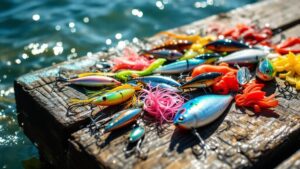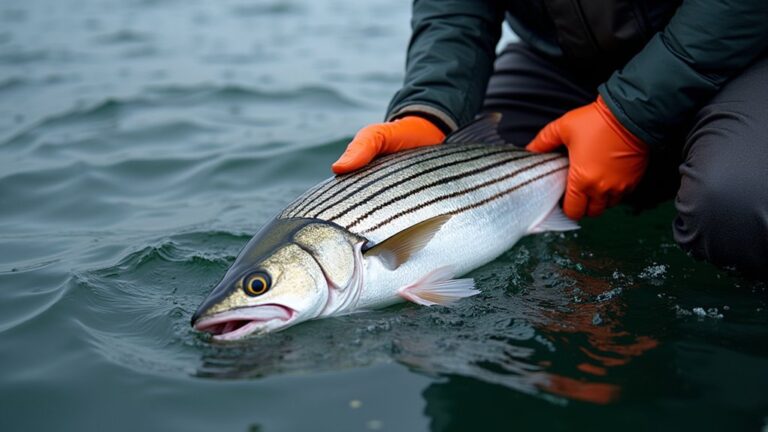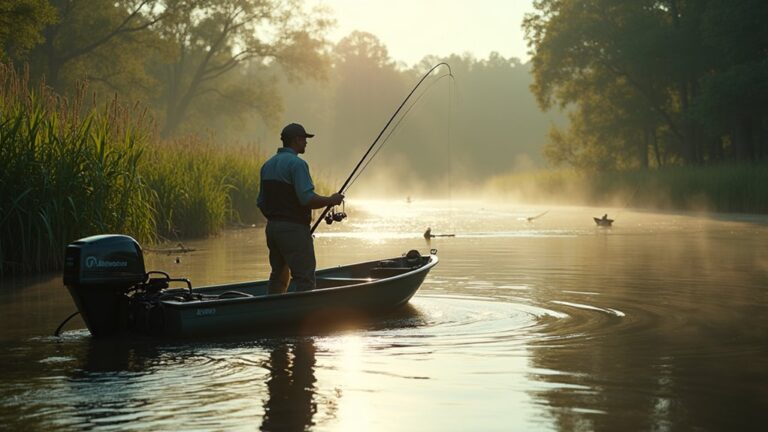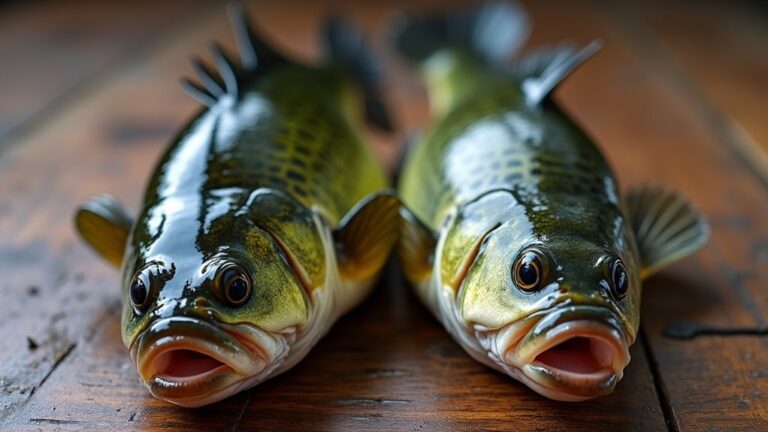When you're targeting saltwater fish, the right bait and lures can make all the difference. Live bait like shrimp and crabs works wonders for species like snapper and tarpon. For dead bait, mackerel and squid are top choices due to their strong scent. If you prefer lures, try topwater plugs or soft plastics to mimic natural prey. Jigs can also be effective, especially for striped bass and redfish. Don't forget to adapt your approach based on the season and fish behavior. Explore these options, and you'll enhance your chances of landing that big catch!
Understanding Saltwater Fish Species
Understanding saltwater fish species is vital for any angler looking to improve their catch. Each species has unique habits, habitats, and feeding patterns that dictate what bait or lure will be most effective.
For example, if you're targeting snapper, you'll find them lurking around reefs and rocky structures. They tend to prefer live bait like shrimp or small fish. On the other hand, if you're after tarpon, you'll want to focus on areas with strong currents where they feed on crabs and smaller baitfish.
Knowing the seasonal migrations of these species is important too. Some fish, like striped bass, are more active during specific months, while others, such as mahi-mahi, are often found in warmer waters during the summer. Understanding the water temperature and seasonal changes can greatly influence your success.
Additionally, consider the time of day. Many saltwater fish are more active during dawn and dusk, making these prime times for fishing.
Live Bait Options
When it comes to saltwater fishing, live bait often proves to be the most effective choice for attracting a variety of species. Using live bait can greatly increase your chances of a successful catch, as many fish are instinctively drawn to the movement and scent of healthy, live prey. Here are some popular live bait options you might consider for your saltwater fishing trips:
| Bait Type | Ideal Species | Best Time to Use |
|---|---|---|
| Shrimp | Snook, Redfish | Early morning, dusk |
| Minnows | Trout, Flounder | All day |
| Crabs | Tarpon, Sheepshead | Near structures |
| Squid | Mahi-Mahi, Snapper | Night fishing |
When selecting live bait, consider the specific fish you're targeting and the local environment. Using the right bait at the right time can make all the difference in your fishing success. Always make certain to check local regulations regarding bait collection and usage to guarantee a responsible fishing experience. Remember, the thrill of catching saltwater fish starts with the right bait!
Best Dead Bait Choices
As you plan your next saltwater fishing adventure, don't overlook the effectiveness of dead bait. Using dead bait can yield impressive results, especially when targeting species like catfish, snapper, and grouper. The key is to choose baits that are both appealing and readily available.
Mackerel is a top choice; its oily flesh and strong scent attract a variety of predatory fish. Similarly, squid is another excellent option, as its natural scent and texture entice fish, making it particularly effective for bottom fishing.
If you're near the shore, consider using cut pieces of mullet or sardines; both are proven favorites for many saltwater species.
For the best results, make certain your dead bait is fresh. If possible, freeze your bait as soon as you catch it to preserve its scent and texture.
You should also remember to use the right rigging techniques to guarantee that your bait stays on the hook and presents well in the water.
Top Artificial Lures
Artificial lures can be game-changers in saltwater fishing, offering versatility and the ability to mimic the movements of live prey. When you're out on the water, using the right lures can make all the difference in attracting fish.
A few top choices include topwater plugs, which create a splash and entice predatory fish to strike. These lures work wonders during dawn and dusk when fish are actively feeding on the surface.
Soft plastics are another excellent option. They come in various shapes and colors, allowing you to imitate different baitfish or crustaceans. Rig them with a weighted hook or a jig head to present them effectively near the bottom or in the water column.
Don't overlook spoons, either. Their flashing action can draw in fish from a distance, making them a favorite among anglers targeting species like mackerel or striped bass.
Finally, consider using swimbaits, which closely resemble the natural movement of baitfish, providing an irresistible target for larger predators.
Experimenting with these artificial lures will enhance your chances of a successful catch, so don't hesitate to give them a try on your next fishing adventure!
Jigs for Saltwater Fishing
Jigs are a fantastic choice for saltwater fishing enthusiasts looking to increase their catch rates. They're versatile and can be used effectively in various conditions, making them a go-to option for both beginners and seasoned anglers. When you're out on the water, the right jig can make all the difference in attracting fish.
Here's a quick reference table to help you choose the best jigs for your saltwater adventures:
| Type of Jig | Best Target Species | Recommended Weight |
|---|---|---|
| Bucktail Jig | Striped Bass | 1-3 oz |
| Swim Jig | Redfish | 1/2-2 oz |
| Scented Jig | Flounder | 1-4 oz |
| Vertical Jig | Snapper | 2-6 oz |
| Flutter Jig | Tuna | 1-4 oz |
When using jigs, consider varying your retrieval speed and technique to find what works best. Experimenting with different colors and sizes can also help you discover the perfect combination to entice those elusive saltwater species. Happy fishing!
Trolling Techniques
When it comes to saltwater fishing, mastering trolling techniques can really up your game. Trolling involves dragging lures or bait through the water while your boat is in motion, which can effectively cover large areas and entice predatory fish.
To get started, choose the right gear. A medium to heavy-action rod paired with a reel that has a high line capacity works best. Use a braided line for better sensitivity and strength.
Next, select your lures. Whether you opt for artificial lures or live bait, make sure to match them to the species you're targeting. Speed is also essential; most saltwater fish prefer a trolling speed between 2 to 6 knots. Adjust your speed based on their activity levels.
Pay attention to your boat's wake and the depth of your lures. Use downriggers or planers to reach deeper waters if needed.
Surface Lures and Popper Types
Trolling isn't the only effective method for attracting saltwater fish; surface lures and poppers can create a thrilling fishing experience. These lures mimic the movements of wounded baitfish, enticing predators lurking beneath the surface. When you use surface lures, you'll often see explosive strikes as fish break the surface to grab their meal.
Poppers, a popular type of surface lure, create a distinctive splashing sound that draws fish in from a distance. You'll want to work them with a steady retrieve, incorporating pauses to let the lure sit briefly. This mimics the erratic behavior of injured prey, increasing your chances of a strike.
Consider the conditions when selecting your surface lures. Bright colors can work wonders in sunny weather, while darker hues may be more effective during overcast days or in murky waters.
Experiment with various sizes and shapes to find what works best for the fish species you're targeting. Whether you're after tuna, mackerel, or snook, surface lures and poppers can add excitement to your fishing adventure, providing you with memorable catches right at the water's surface.
Choosing the Right Hooks
Choosing the right hooks is crucial for successful saltwater fishing, as they can greatly impact your catch rates. When selecting hooks, consider the type of fish you're targeting. Different species have different mouth sizes and shapes, so using the right hook size can make all the difference.
For larger fish like tarpon or shark, opt for stronger, wider hooks that can withstand their powerful runs. A circle hook is a popular choice for catch-and-release fishing, as it's designed to hook the fish in the corner of the mouth, reducing injury.
For smaller species, like snapper, a lighter, smaller hook will work best.
Pay attention to the hook's material as well. Stainless steel hooks resist rust and corrosion, making them ideal for saltwater environments. Additionally, verify your hooks are sharp. A sharp hook penetrates the fish's mouth more easily, improving your chances of a successful catch.
Lastly, always carry a variety of hooks in your tackle box. This allows you to adapt to different fishing conditions and species. With the right hooks, you'll increase your odds of bringing home a great catch.
Seasonal Bait Considerations
Understanding seasonal bait considerations is key to optimizing your saltwater fishing experience. Different seasons bring changes in water temperature, fish behavior, and bait availability.
In spring, you'll find fish active and feeding aggressively. Using live bait like shrimp or small baitfish can yield great results as fish prepare for spawning.
As summer rolls in, fish often seek cooler waters. This is the time to switch to larger baits, such as mullet or cut bait, to attract bigger predators.
In fall, you can take advantage of the migration as baitfish move closer to shore. Target schools of baitfish with lures that mimic their movement, like topwater plugs or spoons.
Winter presents a unique challenge; fish become less active in colder water. You might want to use smaller, more subtle baits like jigs or soft plastics.
Focusing on deeper water spots can also help you find fish seeking warmth.
Tips for Successful Fishing
Having the right bait and lures is only part of the equation for a successful day on the water. You need to pay attention to several factors to maximize your chances of reeling in fish.
First, consider the time of day. Fish are often more active during dawn and dusk, so plan your trips around these times.
Next, observe the weather conditions. Overcast days can lead to better fishing opportunities, as fish tend to roam more freely. Don't forget to check the tides; fish are more likely to be feeding during incoming or outgoing tides.
When setting up, be mindful of your casting technique. A quiet approach is crucial—splashing can scare off fish. Experiment with different retrieval speeds to see what works best on any given day.
Keep your line and gear in top shape. Regularly check for tangles or damage, as these can lead to missed opportunities.
Finally, be patient. Fishing can require time and persistence, so stay focused and enjoy the experience, even if you don't catch anything right away.
With these tips, you're well on your way to a successful fishing adventure!
Conclusion
In the world of saltwater fishing, choosing the right bait can mean the difference between a day of frustration and a haul of memories. Whether you lean toward the lively wiggle of a live bait or the sharp action of an artificial lure, each option offers its own thrill. Remember, the ocean's bounty rewards those who adapt and experiment. So gear up, embrace the adventure, and let the tides guide you to your next big catch!




